Abstract
Purpose: To figure out plasma homocysteine (Hcy) status in patients with subclinical hypothyroidism (SH) and overt hypothyroidism (OH) compared with healthy subjects, and the effect of levothyroxine (L-T4) on plasma homocysteine status in patients with hypothyroidism.Methods: PubMed Web of Science, and The Cochrane Library were used to identify eligible studies. The Newcastle-Ottawa Quality Assessment Scale was used to assess the quality of selected studies. All analyses were performed using the STATA, version 12 software. Results: Our meta-analysis indicated that plasma Hcy concentrations elevated in OH patients without L-T4 treatment compared with healthy subjects. However, this elevation was not observed in the comparison between patients withSH without L-T4 treatment and healthy subjects. Moreover, plasma Hcy levels were found to be higher in patients with OH without L-T4 treatment than in patients with SH without L-T4 treatment. Finally, plasma Hcy concentrations decreased after L-T4 treatment in patients with SH or OH. Conclusions: Plasma Hcy status is associated with the severity of hypothyroidism and L-T4 treatment is helpful for patients with hypothyroidism to reduce the plasma Hcy levels.
Keywords: Homocysteine, subclinical hypothyroidism, overt hypothyroidism, levothyroxine, meta-analysis
Introduction
Hypothyroidismis divided into two types, subclinical hypothyroidism (SH) and overt hypothyroidism (OH), according to the decrease extent of thyroid function. SH is a condition defined as a persistently raised serum thyroid stimulating hormone (TSH) level in the presence of normal free thyroxine (fT4) [1]. Subclinical thyroid failure is often asymptomatic; 30% patientswith SH may have symptoms indicatingthe deficiency of thyroid hormone [2]. Recently, SH has been reported to be closely associated with atherosclerosis and myocardial infarction in elderly women [3]. OH, defined by high TSH levels with low levels of fT4 and/or free triiodothyronine (fT3), is a risk factor for cardiovascular diseases, especially coronary heart diseases [4].
Increasing attention is paid to the risk of cardiovascular diseases in patients with hypothyroidismrecently. Homocysteine (Hcy), a sulfhydryl-containing amino acid synthesized during the conversion of methionine to cysteine [5], has been identified as an independently risk factor for the progression ofvascular diseases [6]. The association between homocysteineand hypothyroidism has been demonstrated in several studies, however, the conclusion is controversial [7-9]. As the major treatment of hypothyroidism, levothyroxine (L-T4) replacement has been used for a long time. The effect of L-T4 treatment on plasma homocysteine status in patients with hypothyroidism has not yet reached a consensus [10-12].
Considering all those conflicting studies, meta-analysis may be an appropriate way to summarize available data to provide more strong evidences than the individual study. This meta-analysis was to elucidate plasma Hcy levels in patients with hypothyroidism, and to evaluate the effect of L-T4 therapy on plasma Hcy levels in patients with hypothyroidism.
Materials and methods
Search strategy
All the studies that investigated the association between plasma Hcy status and hypothyroidism with/without L-T4 replacement were considered in this meta-analysis. A comprehensive literature search was performed for original articles published up from January 1990 to July, 2014 using PubMed, Web of Science databases and The Cochrane Library. The search was restricted to articles in English.As a search criterion, we used the following terms: “hypothyroidism”, “subclinical hypothyroidism”, “overt hypothyroidism”, “homocysteine”, “Hcy”, “levothyroxine”, “L-Thyroxine”, “L-T4” and “thyroid hormone”. References of retrieved articles were also reviewed in case of omitting additional published studies not included in PubMed, Web of Science databases and The Cochrane Library.
Study selection
First screening was based on titles and abstracts of retrievedarticles, any article lacking the information regarding plasma Hcystatus in patients with hypothyroidism was rejected. Editorials, abstracts, review articles and in vitro studies were also excluded. Next, second screening was based on the full texts of interested articles. Studies were considered eligible if they met the following criteria: 1) cross-sectional, case-control, prospective or cohort study; 2); controlled design studies, plasma Hcy levels in patients with SH or OH compared with healthy subjects; 3) effect of L-T4 treatment on patients with SH or OH; 4) data of interest (plasma Hcy concentration) presented as continuous (mean value± SD); 5) mean duration of L-T4 treatment: at least 2 months.
Quality scale
The Newcastle-Ottawa Quality Assessment Scale was used here toassess the quality of enrolled studies. The quality scores of included studies ranged from 5 to 6 (low quality: 1-3, median quality: 4-6, high quality: 7-9). As showed in Table 1.
Table 1.
Characteristics of studies included in this meta-analysis
| Control | Case 1 | Case 2 | Case 3 | Case 4 | Quality score | |||||||||||||
|---|---|---|---|---|---|---|---|---|---|---|---|---|---|---|---|---|---|---|
|
|
|
|
|
|
||||||||||||||
| Study | Year | Country | N (F/M) | Age (Y) | Hcy (μM) | N (F/M) | Age (Y) | Hcy (μM) | N (F/M) | Age (Y) | Hcy (μM) | N (F/M) | Age (Y) | Hcy (μM) | N (F/M) | Age (Y) | Hcy (μM) | |
| Bičíková et al | 2001 | Czech | No | No | No | No | No | No | No | No | No | 14 (12/2) | 42±10 | 15.6±3.6 | 14 (12/2) | 42±10 | 9.9±1.6 | 5 |
| Deicher et al | 2002 | Austria | No | No | No | 37 (31/6) | 50±18 | 9.9±2.9 | 37 (31/6) | 50±18 | 9.6±3.5 | No | No | No | No | No | No | 5 |
| Bičíková et al | 2002 | Czech | No | No | No | No | No | No | No | No | No | 16 (16/0) | 35±8.82 | 19.2±3.2 | 16 (16/0) | 35±8.82 | 10.6±2.9 | 5 |
| Christ-Crain et al | 2003 | Switzerland | 40 | 54.1±9.2 | 11.3±2.8 | 63 | 57.5±9.8 | 11.0±2.7 | 31 | No | 11.1±3.4 | 61 | 55.7±11.7 | 14.4±9.1 | No | No | No | 6 |
| Atabek et al | 2003 | Turkey | 19 | 15±1.8 | 6.6±1.8 | 19 | 14.9±1.9 | 6.7±1.8 | No | No | No | No | No | No | No | No | No | 5 |
| Luboshitzky et al | 2004 | Israel | 19 (19/0) | 51.7±10.1 | 9.8±2.6 | 44 (44/0) | 51.6±9.7 | 9.1±2.4 | No | No | No | 10 (10/0) | 50.1±8.8 | 13.0±7.9 | No | No | No | 6 |
| Pe’rez et al | 2004 | Spain | No | No | No | 42 (36/6) | 51.7±15 | 9.5±2.93 | 42 (36/6) | 51.7±15 | 9.4±3.7 | No | No | No | No | No | No | 6 |
| Ozcan et al | 2005 | Turkey | 33 | 41.8±10.2 | 9.39±2.45 | 84 | 41.6±12.4 | 9.91±2.30 | 84 | 41.6±12.4 | 9.34±2.19 | No | No | No | No | No | No | 5 |
| Beyhan et al | 2006 | Turkey | No | No | No | 75 (50/25) | 42.4±13.1 | 10±2.5 | 75 (50/25) | 42.4±13.1 | 9.6±2.5 | No | No | No | No | No | No | 6 |
| Cakal et al | 2007 | Turkey | 11 | 39.9±12.5 | 7.9±0.6 | 15 | 41.4±14.1 | 9.2±3.3 | 15 | 41.4±14.1 | 7.8±2.1 | 20 | 41.3±11.1 | 10.3±3.4 | 20 | 41.3±11.1 | 7.7±2.3 | 6 |
| Turhan et al | 2008 | Turkey | 50 (47/3) | 38.2±10.7 | 9.6±3.1 | 53 (47/6) | 40.8±12.1 | 10.3±3.4 | No | No | No | No | No | No | No | No | No | 6 |
| Erdal et al | 2008 | Turkey | 63 (55/8) | 39.43±13.02 | 9.71±6.90 | 60 (55/5) | 42.28±12.65 | 9.92±2.22 | 60 (55/5) | 42.28±12.65 | 9.36±1.90 | No | No | No | No | No | No | 5 |
| Adrees et al | 2009 | Ireland | 56 (56/0) | 47±8 | 7.8±2.1 | 56 (56/0) | 50±9 | 10.4±3.6 | 52 (52/0) | 52±10 | 9.1±2.0 | No | No | No | No | No | No | 6 |
| Ma et al | 2012 | China | 35 (20/15) | 43±12 | 10.37±3.77 | No | No | No | No | No | No | 35 (25/10) | 43±11 | 15.78±6.97 | 35 (25/10) | 43±11 | 12.39±5.67 | 6 |
| Bamashmoss et al | 2013 | Yemen | 20 (18/2) | 29.75±6.15 | 11.48±3.03 | No | No | No | No | No | No | 30 (27/3) | 37.43±6.92 | 24.45±5.50 | No | No | No | 6 |
| Kutluturket al | 2013 | Turkey | No | No | No | No | No | No | No | No | No | 54 (47/7) | 20-75 | 9.67±5.24 | 54 (47/7) | 20-75 | 8.16±3.38 | 6 |
| Anaqnostis et al | 2014 | Greece | No | No | No | 32 (30/2) | 52.1±13.9 | 11.29±4.45 | 32 (30/2) | 52.1±13.9 | 11.94±10.28 | No | No | No | No | No | No | 6 |
No = undescribed, Control = healthy people, Case 1 = subclinical hypothyroidism without L-T4 treatment, Case 2 = subclinical hypothyroidism after L-T4 treatment, Case 3 = overt hypothyroidism without L-T4 treatment, Case 4 = overt hypothyroidism after L-T4 treatment, Hcy = homocysteine mean ± SD (μM).
Data extraction
The data of interest were extracted by two investigators from each article and another senior reviewerchecked all items for completeness and accuracy. Information was recorded as follows: first author’s surname, publication year, subjects’ country, total number of participant subjects, mean ages of controls and cases, plasma Hcylevels in all groups.
Statistical analyses
Standard mean deviation (SMD) was used as effect measure to assess the differences in plasma Hcyconcentrations among controls and cases. Heterogeneity of SMDs was quantified using I-square (I2) test. I2>50% was considered as significant heterogeneity [13]. If there was no heterogeneity, SMDs were calculated using fixed-effects model. If not, random-effects model was applied.Potential publication bias was assessed by Begg’s and Egger’s test. All analyses were performed using STATA version 12.0 (Stata Corp, College Station, TX, USA).
Results
Literature search
We initially obtained 101 studies from PubMed, Web of Science databases and The Cochrane Library. After 37 duplicated studies removed, 21 studies were then excluded by reviewing titles and abstracts, mainly because they were editorials, reviewsor irrelevant to topics. Then 26 full-text studies were excluded due to some detail reasons showed in Figure 1. Finally, 17 studies [4,7-12,14-23] were enrolled in our meta-analysis.
Figure 1.
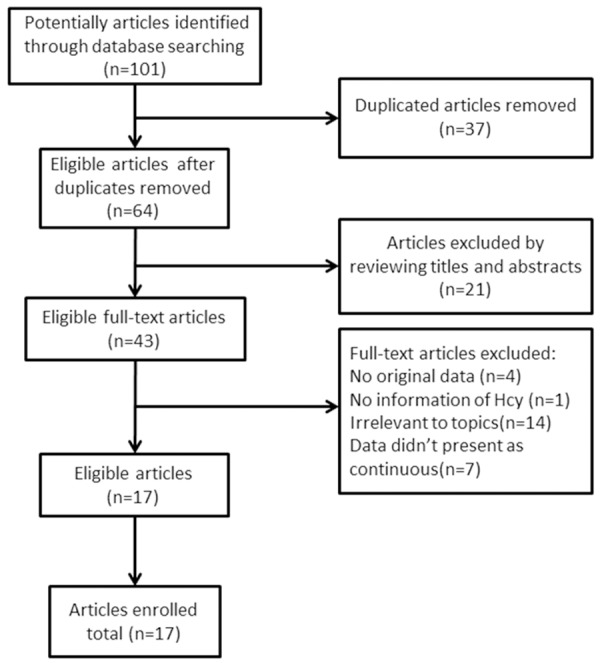
Search strategy for meta-analysis.
Study characteristics
The characteristics of the 17 enrolled studies are shown in Table 1. There were 5 case-control studies [4,8,9,18,21], 12 prospective studies [7,10-12,14-17,19,20,22,23]. The mean age of each group ranged from 14.9 to 57.5 years which were generally matched in healthy controls and other cases. The duration of L-T4 treatment ranged from 2 months to 18 months. The sizes of studies ranged from 14 to 164.
Meta-analysis of plasma Hcy levels
Firstly, we compared plasma Hcy concentrations between patients with SH without L-T4 treatment and healthy subjects, and found that plasma Hcy levels in patients with SH without L-T4 treatment were similar to that in healthy subjects [8 studies, SMD: 0.19, 95% confidence interval (CI): -0.07 to 0.45, p=0.159, as shown in Figure 2]. Significant heterogeneity was observed among studies (I2=62.9%, p=0.009). No evidence of publication bias was noted (Begg, p=0.902; Egger, p=0.858). We then turn to sensitivity analysis, 1 studies [1] was excluded because it was appearing to be outliers with other studies (Figure 3). After exclusion, a meta-analysis of other 7 studies indicated that the main results remained unchanged, a significant elevation or reduction of plasma Hcy levels was not observed in patients with SH without L-T4 treatment compared with healthy subjects (SMD: 0.07, CI: -0.10 to 0.24, p=0.425). There was no significant heterogeneity among studies (I2=0.0%, p=0.578). No evidence of publication bias was noted (Begg, p=0.548; Egger, p=0.600).
Figure 2.
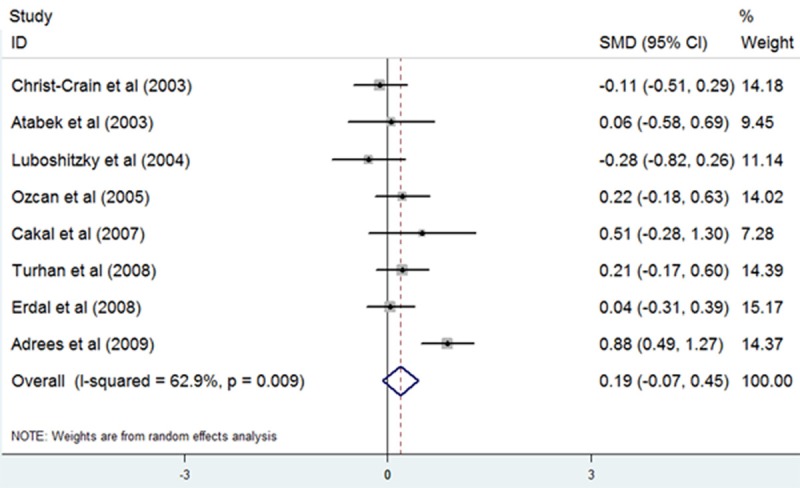
Comparison of plasma homocysteine level between subclinical hypothyroidism patients without levothyroxine treatment and healthy subjects.
Figure 3.
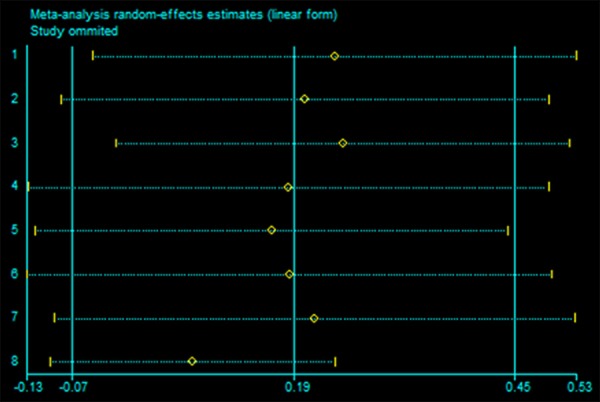
Sensitivity analysis to investigate the influence of a single study on the overall meta-analysis, which compares plasma homocysteine level between subclinical hypothyroidism patients without levothyroxine treatment and healthy subjects.
Next, we compared plasma Hcy concentrations between patients with OH without L-T4 treatment and healthy subjects, and found that plasma Hcy levels were significantly higherin patients with OH without L-T4 treatment than in healthy subjects (5 studies, SMD: 1.10, CI: 0.39 to 1.81, p=0.003, as shown in Figure 4). Significant heterogeneity was observed among studies (I2=85.3%, p=0). No evidence of publication bias was noted (Begg, p=0.462; Egger, p=0.283). We also use sensitivity analysis to exclude those studies that were appearing to be different from others. After excluded 1 study [4], a meta-analysis of other 4 studies indicated that the main results remained unchanged, a significant elevation of plasma Hcy levels was observed in patients with OH without L-T4 treatment compared with healthy subjects (SMD: 0.67, CI: 0.40 to 0.94, p=0). There was no significant heterogeneity among studies (I2=1.3%, p=0.385). No evidence of publication bias was noted (Begg, p=1; Egger, p=0.562).
Figure 4.
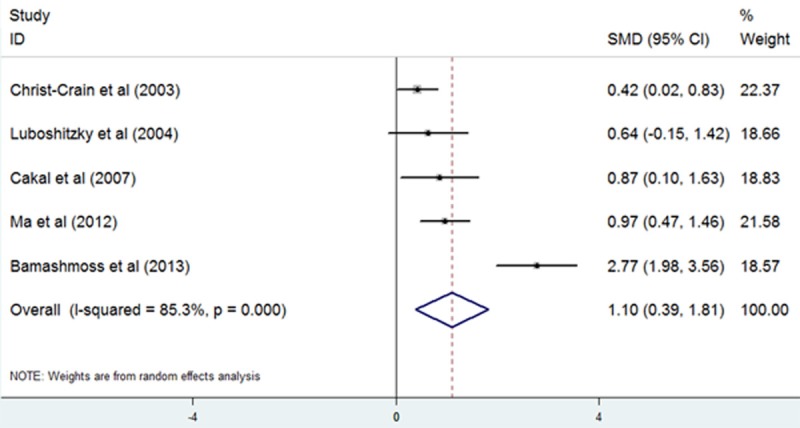
Comparison of plasma homocysteine level between overt hypothyroidism patients without levothyroxine treatment and healthy subjects.
Plasma Hcy concentrations were then compared between patients with SH without L-T4 treatment and patients with OH without L-T4 treatment. Results showed that plasma Hcy levels were higher in patients with OH without L-T4 treatment than in patients withSH without L-T4 treatment (3 studies, SMD: 0.56, CI: 0.27 to 0.84, p=0, as shown in Figure 5). There was no significant heterogeneity among studies (I2=0.0%, p=0.383). No evidence of publication bias was noted (Begg, p=1; Egger, p=0.773).
Figure 5.
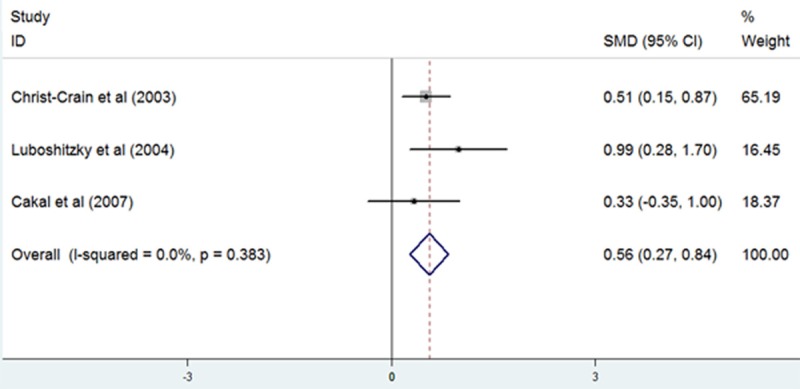
Comparasion of plasma homocysteine level between overt hypothyroidism patients without levothyroxine treatment and subclinical hypothyroidism patients without levothyroxine treatment.
Plasma Hcy levels were lower in patients with SH with L-T4 treatment than patients with SH without L-T4 treatment (9 studies, SMD: -0.18, CI: -0.32 to -0.05, p=0.006, as shown in Figure 6). There was no significant heterogeneity among studies (I2=0.0%, p=0.678). No evidence of publication bias was noted (Begg, p=0.466; Egger, p=0.757).
Figure 6.
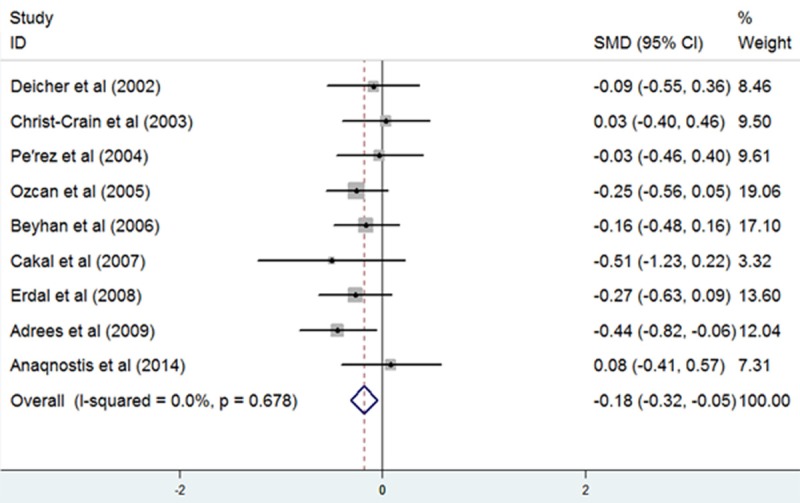
Comparasion of plasma homocysteine level between subclinical hypothyroidism patients with levothyroxine treatment and subclinical hypothyroidism patients without levothyroxine treatment.
Finally, we compared plasma Hcy concentrations between patients with OH with L-T4 treatment and patients with OH without L-T4 treatment, and found that plasma Hcy levels were significantly lower in patients with OH with L-T4 treatment than in patients with OH without L-T4 treatment (5 studies, SMD: -1.22, CI: -1.96 to -0.47, p=0.001, as shown in Figure 7). Significant heterogeneity was observed among studies (I2=86.4%, p=0). Begg’s test (p=0.027) and Egger’s test (p=0.007) indicated the existence of publication bias. We then used the trim-and-fill method to adjust for funnel plot asymmetry, however, results showed no trimming performed and data unchanged. After excluded 2 studies [12,20] by using sensitivity analysis, a meta-analysis of other 3 studies indicated that the main results remained unchanged, a significant reduction of plasma Hcy levels was observed in patients with OH with L-T4 treatment compared with patients with OH without L-T4 treatment (SMD: -0.50, CI: -0.77 to -0.23, p=0). There was no significant heterogeneity among studies (I2=4.6%, p=0.351). Nevertheless, Begg’s test (p=0.296) and Egger’s test (p=0.010) indicated the existence of publication bias.
Figure 7.
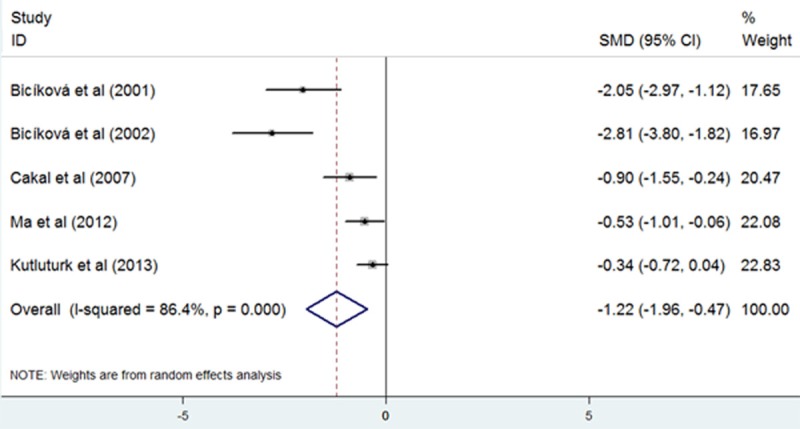
Comparasion of plasma homocysteine level between overt hypothyroidism patients with levothyroxine treatment and overt hypothyroidism patients without levothyroxine treatment.
Discussion
Plasma Hcy level is affected by several genetic, physiological and life-style factors [24,25]. The reasons for hyperhomocysteinemia are excess of dietary methionine, deficit of folate and vitamins taking part in Hcy metabolism, and deficit of kidney function [26,27]. Kidney is a major issue for removal and metabolism of Hcy, which is closely associated with glomerular filtration rate (GFR) and albuminuria [28]. Hyperhomocysteinemia induces endothelial injury, oxidative stress, oxidation of LDL-cholesterol and smooth muscle hypertrophy [29,30]. Toxic effect of Hcy and its spontaneous oxidation product, homocysteic acid, have the ability to activate N-methyl-D-aspartic acid (NMDA) receptors, then increase intracellular levels of calcium ion and reactive oxygen species [31,32]. Moreover, platelet aggregation, vasomotor function and plasma anticoagulant function are altered in the presence of elevated plasma Hcy concentrations [33]. Hyperhomocysteinemia is also one of the pathogenic factors for neuropathy, such as brain stroke and Alzheimer’s disease [34]. Severe hyperhomocysteinemia can lead to convulsions and dementia [35].
Thyroid hormones strongly affect the heart and the vascular system [36]. Hypothyroidism is a common condition that is related to premature atherosclerosis and its clinical consequences, such as myocardial infarction [37]. Autopsy findingssupportan increase in atherosclerosis events in patients displaying hypothyroidism [38]. Several studies reported that plasma Hcy concentrations elevated in patients with OH compared with those healthy subjects [7,39]. Consistent with these studies, the results of our meta-analysis indicated a higher plasma Hcy levels in patients with OH than in healthy subjects who have euthyroidism. The elevation of plasma Hcy level can be explained by impaired renal clearance or reduced urinary excretion in hypothyroidism [7]. The haemodynamic effects of hypothyroidism may be the reason of reduced renal blood flow and GFR [40]. Experimental studies have also implied that methylenetetrahydrofolate reductase, a key enzyme in folate metabolism, decreased in patients with hypothyroidism [39,41]. As the major determinant of plasma Hcystatus, folate level decreases in patients with hypothyroidism, leading to elevated plasma Hcy status.
Auer J et aldemonstrated that variation of thyroid function within the normal range might affect the presence and severity of coronary atherosclerosis [42]. Taddei and his co-workers also identified a great prevalence of endothelial dysfunction in patients with SH, resulting from a reduction in NO availability [43]. However, the evidences are still judged as insufficient [44,45]. Our meta-analysis indicated that plasma Hcy concentrations in patients with SH were similar to that in healthy subjects. This phenomenon can beinterpreted as a hypothesis that slight reduction in renal function and methylenetetrahydrofolate reductase may be insufficient to influence plasma Hcy status. We also observed an elevation of plasma Hcy levels in patients with OH compared with patients with SH, which indicated that with the progression of hypothyroidism, the alteration of plasma Hcy concentrations became more and more obvious.
A randomized controlled prospective study, assessing the effect of L-T4 treatment on patients with hypothyroidism, showed a reduction in body weight, although slight, after 3 months [46]. It is also reported that L-T4 replacement decreasedblood pressure and central arterial stiffness and improved endothelium-dependent vasodilatation in patients with SH [15,47]. Moreover, a significant increase in plasma high-density lipoprotein cholesterollevels was found in patients with SH after 3 months of L-T4 treatment [48]. Another study indicated that L-T4 therapy might cause a reduction in lipoprotein (a) status in patients with OH [49]. However, a conflicting study claimed that L-T4 substitution therapy had no effect on cardiovascular risk profile in patients with hypothyroidism [10]. Besides the dose treatment duration of L-T4, hypothyroidismseverity and duration may also contribute to the elevation of plasma Hcy levels. In our meta-analysis, plasma Hcy concentrations decrease after L-T4 treatment in patients with SH or OH.
Even though our meta-analysis enrolls relatively high-quality articles which shared similar characteristics, there were some limitations existing in this investigation. First, detection methods of plasma Hcy concentration varies among enrolled studies, which mayaffect the accuracy of plasma Hcy concentration. Second, Clinical diversity among the studies enrolled in this meta-analysiswill result in statistical heterogeneity, which mayinfluence the outcomes, although a random effects model is used. Third, calculated Begg’s and Egger’s tests indicatethe existence of publication bias. We are unable to obtain the original data from corresponding authors.Fourth, we need more high-quality and large-samplestudies included in our meta-analysis.
Taken together, this meta-analysis suggests that the status of plasma Hcy is associated with the severity of hypothyroidism and L-T4 treatment is good for patients with hypothyroidism to reduce the plasma Hcy levels.
Disclosure of conflict of interest
None.
References
- 1.Hollowell JG, Staehling NW, Flanders WD, Hannon WH, Gunter EW, Spencer CA, Braverman LE. Serum TSH, T(4), and thyroid antibodies in the United States population (1988 to 1994): National Health and Nutrition Examination Survey (NHANES III) J Clin Endocrinol Metab. 2002;87:489–499. doi: 10.1210/jcem.87.2.8182. [DOI] [PubMed] [Google Scholar]
- 2.Canturk Z, Cetinarslan B, Tarkun I, Canturk NZ, Ozden M, Duman C. Hemostatic system as a risk factor for cardiovascular disease in women with subclinical hypothyroidism. Thyroid. 2003;13:971–977. doi: 10.1089/105072503322511382. [DOI] [PubMed] [Google Scholar]
- 3.Hak AE, Pols HA, Visser TJ, Drexhage HA, Hofman A, Witteman JC. Subclinical hypothyroidism is an independent risk factor for atherosclerosis and myocardial infarction in elderly women: the Rotterdam Study. Ann Intern Med. 2000;132:270–278. doi: 10.7326/0003-4819-132-4-200002150-00004. [DOI] [PubMed] [Google Scholar]
- 4.Bamashmoos SA, Al-Nuzaily MA, Al-Meeri AM, Ali FH. Relationship between total homocysteine, total cholesterol and creatinine levels in overt hypothyroid patients. Springerplus. 2013;2:423. doi: 10.1186/2193-1801-2-423. [DOI] [PMC free article] [PubMed] [Google Scholar]
- 5.Veeranki S, Tyagi SC. Defective homocysteine metabolism: potential implications for skeletal muscle malfunction. Int J Mol Sci. 2013;14:15074–15091. doi: 10.3390/ijms140715074. [DOI] [PMC free article] [PubMed] [Google Scholar]
- 6.Sadeghian S, Fallahi F, Salarifar M, Davoodi G, Mahmoodian M, Fallah N, Darvish S, Karimi A. Homocysteine, vitamin B12 and folate levels in premature coronary artery disease. BMC Cardiovasc Disord. 2006;6:38. doi: 10.1186/1471-2261-6-38. [DOI] [PMC free article] [PubMed] [Google Scholar]
- 7.Christ-Crain M, Meier C, Guglielmetti M, Huber PR, Riesen W, Staub JJ, Muller B. Elevated C-reactive protein and homocysteine values: cardiovascular risk factors in hypothyroidism? A cross-sectional and a double-blind, placebo-controlled trial. Atherosclerosis. 2003;166:379–386. doi: 10.1016/s0021-9150(02)00372-6. [DOI] [PubMed] [Google Scholar]
- 8.Turhan S, Sezer S, Erden G, Guctekin A, Ucar F, Ginis Z, Ozturk O, Bingol S. Plasma homocysteine concentrations and serum lipid profile as atherosclerotic risk factors in subclinical hypothyroidism. Ann Saudi Med. 2008;28:96–101. doi: 10.5144/0256-4947.2008.96. [DOI] [PMC free article] [PubMed] [Google Scholar]
- 9.Luboshitzky R, Herer P. Cardiovascular risk factors in middle-aged women with subclinical hypothyroidism. Neuro Endocrinol Lett. 2004;25:262–266. [PubMed] [Google Scholar]
- 10.Anagnostis P, Efstathiadou ZA, Slavakis A, Selalmatzidou D, Poulasouchidou M, Katergari S, Karathanasi E, Dogramatzi F, Kita M. The effect of L-thyroxine substitution on lipid profile, glucose homeostasis, inflammation and coagulation in patients with subclinical hypothyroidism. Int J Clin Pract. 2014;68:857–863. doi: 10.1111/ijcp.12394. [DOI] [PubMed] [Google Scholar]
- 11.Perez A, Cubero JM, Sucunza N, Ortega E, Arcelus R, Rodriguez-Espinosa J, Ordonez-Llanos J, Blanco-Vaca F. Emerging cardiovascular risk factors in subclinical hypothyroidism: lack of change after restoration of euthyroidism. Metabolism. 2004;53:1512–1515. doi: 10.1016/j.metabol.2004.05.016. [DOI] [PubMed] [Google Scholar]
- 12.Bicikova M, Tallova J, Hill M, Vanuga A, Putz Z, Tomandl J. Effect of treatment of hypothyroidism on the plasma concentrations of neuroactive steroids and homocysteine. Clin Chem Lab Med. 2001;39:753–757. doi: 10.1515/CCLM.2001.125. [DOI] [PubMed] [Google Scholar]
- 13.Higgins JP, Thompson SG, Deeks JJ, Altman DG. Measuring inconsistency in meta-analyses. BMJ. 2003;327:557–560. doi: 10.1136/bmj.327.7414.557. [DOI] [PMC free article] [PubMed] [Google Scholar]
- 14.Kutluturk F, Yuce S, Tasliyurt T, Yelken BM, Aytan P, Ozturk B, Yilmaz A. Changes in metabolic and cardiovascular risk factors before and after treatment in overt hypothyroidism. Med Glas (Zenica) 2013;10:348–353. [PubMed] [Google Scholar]
- 15.Adrees M, Gibney J, El-Saeity N, Boran G. Effects of 18 months of L-T4 replacement in women with subclinical hypothyroidism. Clin Endocrinol (Oxf) 2009;71:298–303. doi: 10.1111/j.1365-2265.2008.03509.x. [DOI] [PubMed] [Google Scholar]
- 16.Deicher R, Vierhapper H. Homocysteine: a risk factor for cardiovascular disease in subclinical hypothyroidism? Thyroid. 2002;12:733–736. doi: 10.1089/105072502760258721. [DOI] [PubMed] [Google Scholar]
- 17.Cakal B, Cakal E, Demirbas B, Ozkaya M, Karaahmetoglu S, Serter R, Aral Y. Homocysteine and fibrinogen changes with L-thyroxine in subclinical hypothyroid patients. J Korean Med Sci. 2007;22:431–435. doi: 10.3346/jkms.2007.22.3.431. [DOI] [PMC free article] [PubMed] [Google Scholar]
- 18.Erdal M, Sahin M, Saglam K, Hasimi A, Uckaya G, Yarpuz MY, Taslipinar A, Gharib H, Kutlu M. Increased serum chitotriosidase activity following restoration of euthyroidism in patients with subclinical hypothyroidism. Intern Med. 2008;47:1309–1314. doi: 10.2169/internalmedicine.47.1013. [DOI] [PubMed] [Google Scholar]
- 19.Ma SG, Yang LX, Bai F, Xu W, Hong B. Ischemia-modified albumin in patients with hyperthyroidism and hypothyroidism. Eur J Intern Med. 2012;23:e136–140. doi: 10.1016/j.ejim.2012.04.011. [DOI] [PubMed] [Google Scholar]
- 20.Bicikova M, Tallova J, Stanicka S, Hill M, Vondra K, Hampl R. Levels of testosterone, allopregnanolone and homocysteine in severe hypothyroidism. Clin Chem Lab Med. 2002;40:1024–1027. doi: 10.1515/CCLM.2002.178. [DOI] [PubMed] [Google Scholar]
- 21.Atabek ME, Pirgon O, Erkul I. Plasma homocysteine concentrations in adolescents with subclinical hypothyroidism. J Pediatr Endocrinol Metab. 2003;16:1245–1248. doi: 10.1515/jpem.2003.16.9.1245. [DOI] [PubMed] [Google Scholar]
- 22.Beyhan Z, Erturk K, Uckaya G, Bolu E, Yaman H, Kutlu M. Restoration of euthyroidism does not improve cardiovascular risk factors in patients with subclinical hypothyroidism in the short term. J Endocrinol Invest. 2006;29:505–510. doi: 10.1007/BF03344139. [DOI] [PubMed] [Google Scholar]
- 23.Ozcan O, Cakir E, Yaman H, Akgul EO, Erturk K, Beyhan Z, Bilgi C, Erbil MK. The effects of thyroxine replacement on the levels of serum asymmetric dimethylarginine (ADMA) and other biochemical cardiovascular risk markers in patients with subclinical hypothyroidism. Clin Endocrinol (Oxf) 2005;63:203–206. doi: 10.1111/j.1365-2265.2005.02326.x. [DOI] [PubMed] [Google Scholar]
- 24.de Bree A, Verschuren WM, Blom HJ, Kromhout D. Lifestyle factors and plasma homocysteine concentrations in a general population sample. Am J Epidemiol. 2001;154:150–154. doi: 10.1093/aje/154.2.150. [DOI] [PubMed] [Google Scholar]
- 25.Schneede J, Refsum H, Ueland PM. Biological and environmental determinants of plasma homocysteine. Semin Thromb Hemost. 2000;26:263–279. doi: 10.1055/s-2000-8471. [DOI] [PubMed] [Google Scholar]
- 26.McNulty H, Pentieva K, Hoey L, Ward M. Homocysteine, B-vitamins and CVD. Proc Nutr Soc. 2008;67:232–237. doi: 10.1017/S0029665108007076. [DOI] [PubMed] [Google Scholar]
- 27.Ruan L, Chen W, Srinivasan SR, Xu J, Toprak A, Berenson GS. Plasma homocysteine is adversely associated with glomerular filtration rate in asymptomatic black and white young adults: the Bogalusa heart study. Eur J Epidemiol. 2009;24:315–319. doi: 10.1007/s10654-009-9340-0. [DOI] [PubMed] [Google Scholar]
- 28.Soedamah-Muthu SS, Chaturvedi N, Teerlink T, Idzior-Walus B, Fuller JH, Stehouwer CD. Plasma homocysteine and microvascular and macrovascular complications in type 1 diabetes: a cross-sectional nested case-control study. J Intern Med. 2005;258:450–459. doi: 10.1111/j.1365-2796.2005.01560.x. [DOI] [PubMed] [Google Scholar]
- 29.Hayden MR, Tyagi SC. Homocysteine and reactive oxygen species in metabolic syndrome, type 2 diabetes mellitus, and atheroscleropathy: the pleiotropic effects of folate supplementation. Nutr J. 2004;3:4. doi: 10.1186/1475-2891-3-4. [DOI] [PMC free article] [PubMed] [Google Scholar]
- 30.Weiss N. Mechanisms of increased vascular oxidant stress in hyperhomocys-teinemia and its impact on endothelial function. Curr Drug Metab. 2005;6:27–36. doi: 10.2174/1389200052997357. [DOI] [PubMed] [Google Scholar]
- 31.Shi Q, Savage JE, Hufeisen SJ, Rauser L, Grajkowska E, Ernsberger P, Wroblewski JT, Nadeau JH, Roth BL. L-homocysteine sulfinic acid and other acidic homocysteine derivatives are potent and selective metabotropic glutamate receptor agonists. J Pharmacol Exp Ther. 2003;305:131–142. doi: 10.1124/jpet.102.047092. [DOI] [PubMed] [Google Scholar]
- 32.Boldyrev A, Bulygina E, Makhro A. Glutamate receptors modulate oxidative stress in neuronal cells. A mini-review. Neurotox Res. 2004;6:581–587. doi: 10.1007/BF03033454. [DOI] [PubMed] [Google Scholar]
- 33.Medina M, Urdiales JL, Amores-Sanchez MI. Roles of homocysteine in cell metabolism: old and new functions. Eur J Biochem. 2001;268:3871–3882. doi: 10.1046/j.1432-1327.2001.02278.x. [DOI] [PubMed] [Google Scholar]
- 34.Seshadri S, Beiser A, Selhub J, Jacques PF, Rosenberg IH, D’Agostino RB, Wilson PW, Wolf PA. Plasma homocysteine as a risk factor for dementia and Alzheimer’s disease. N Engl J Med. 2002;346:476–483. doi: 10.1056/NEJMoa011613. [DOI] [PubMed] [Google Scholar]
- 35.Watkins JC, Jane DE. The glutamate story. Br J Pharmacol. 2006;147(Suppl 1):S100–108. doi: 10.1038/sj.bjp.0706444. [DOI] [PMC free article] [PubMed] [Google Scholar]
- 36.Klein I, Ojamaa K. Thyroid hormone and the cardiovascular system. N Engl J Med. 2001;344:501–509. doi: 10.1056/NEJM200102153440707. [DOI] [PubMed] [Google Scholar]
- 37.Cappola AR, Ladenson PW. Hypothyroidism and atherosclerosis. J Clin Endocrinol Metab. 2003;88:2438–2444. doi: 10.1210/jc.2003-030398. [DOI] [PubMed] [Google Scholar]
- 38.Gaspar IA. Postmortem observations on the thyroid in atherosclerosis. J Am Geriatr Soc. 1968;16:686–695. doi: 10.1111/j.1532-5415.1968.tb01278.x. [DOI] [PubMed] [Google Scholar]
- 39.Lien EA, Nedrebo BG, Varhaug JE, Nygard O, Aakvaag A, Ueland PM. Plasma total homocysteine levels during short-term iatrogenic hypothyroidism. J Clin Endocrinol Metab. 2000;85:1049–1053. doi: 10.1210/jcem.85.3.6439. [DOI] [PubMed] [Google Scholar]
- 40.Vargas F, Moreno JM, Rodriguez-Gomez I, Wangensteen R, Osuna A, Alvarez-Guerra M, Garcia-Estan J. Vascular and renal function in experimental thyroid disorders. Eur J Endocrinol. 2006;154:197–212. doi: 10.1530/eje.1.02093. [DOI] [PubMed] [Google Scholar]
- 41.Morris MS, Bostom AG, Jacques PF, Selhub J, Rosenberg IH. Hyperhomocysteinemia and hypercholesterolemia associated with hypothyroidism in the third US National Health and Nutrition Examination Survey. Atherosclerosis. 2001;155:195–200. doi: 10.1016/s0021-9150(00)00537-2. [DOI] [PubMed] [Google Scholar]
- 42.Auer J, Berent R, Weber T, Lassnig E, Eber B. Thyroid function is associated with presence and severity of coronary atherosclerosis. Clin Cardiol. 2003;26:569–573. doi: 10.1002/clc.4960261205. [DOI] [PMC free article] [PubMed] [Google Scholar]
- 43.Taddei S, Caraccio N, Virdis A, Dardano A, Versari D, Ghiadoni L, Salvetti A, Ferrannini E, Monzani F. Impaired endothelium-dependent vasodilatation in subclinical hypothyroidism: beneficial effect of levothyroxine therapy. J Clin Endocrinol Metab. 2003;88:3731–3737. doi: 10.1210/jc.2003-030039. [DOI] [PubMed] [Google Scholar]
- 44.Helfand M. Screening for subclinical thyroid dysfunction in nonpregnant adults: a summary of the evidence for the U. S. Preventive Services Task Force. Ann Intern Med. 2004;140:128–141. doi: 10.7326/0003-4819-140-2-200401200-00015. [DOI] [PubMed] [Google Scholar]
- 45.Surks MI, Ortiz E, Daniels GH, Sawin CT, Col NF, Cobin RH, Franklyn JA, Hershman JM, Burman KD, Denke MA, Gorman C, Cooper RS, Weissman NJ. Subclinical thyroid disease: scientific review and guidelines for diagnosis and management. JAMA. 2004;291:228–238. doi: 10.1001/jama.291.2.228. [DOI] [PubMed] [Google Scholar]
- 46.Razvi S, Ingoe L, Keeka G, Oates C, McMillan C, Weaver JU. The beneficial effect of L-thyroxine on cardiovascular risk factors, endothelial function, and quality of life in subclinical hypothyroidism: randomized, crossover trial. J Clin Endocrinol Metab. 2007;92:1715–1723. doi: 10.1210/jc.2006-1869. [DOI] [PubMed] [Google Scholar]
- 47.Anagnostis P, Karagiannis A, Tziomalos K, Athyros VG, Kita M, Mikhailidis DP. Endocrine hypertension: diagnosis and management of a complex clinical entity. Curr Vasc Pharmacol. 2010;8:646–660. doi: 10.2174/157016110792006996. [DOI] [PubMed] [Google Scholar]
- 48.Mutlu S, Parlak A, Aydogan U, Aydogdu A, Soykut B, Akay C, Saglam K, Taslipinar A. The effect of levothyroxine replacement therapy on lipid profile and oxidative stress parameters in patients with subclinical hypothyroid. Arch Pharm Res. 2013 doi: 10.1007/s12272-013-0227-y. [Epub ahead of print] [DOI] [PubMed] [Google Scholar]
- 49.Tzotzas T, Krassas GE, Konstantinidis T, Bougoulia M. Changes in lipoprotein(a) levels in overt and subclinical hypothyroidism before and during treatment. Thyroid. 2000;10:803–808. doi: 10.1089/thy.2000.10.803. [DOI] [PubMed] [Google Scholar]


